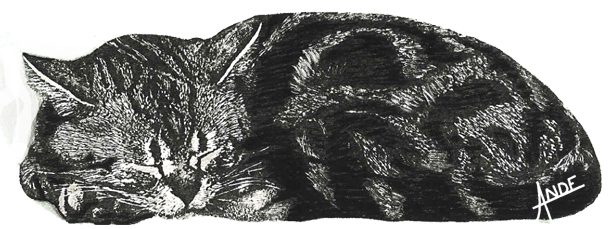
by Ande DeGeer (2003)
If you close your eyes and visualize the beautiful shorthaired cat that slept on your bed and comforted you when you were a child, you are very likely picturing a cat that closely resembles the American Shorthair. The perfect family cat, the American Shorthair is known for its intelligence, quiet disposition, beauty, and hardy build.
Every part of its structure allows it to move with power, endurance, and agility. There is nothing about its appearance that is exaggerated. The general effect is that of a strongly built, well-balanced, symmetrical cat. The cat is surprisingly heavy. Even the female, which may be slightly smaller than the male, has a well-padded and muscled body. The breed usually achieves full growth at approximately three to four years old with the mature males weighing eleven to fifteen pounds and the mature females weighing eight to twelve pounds.
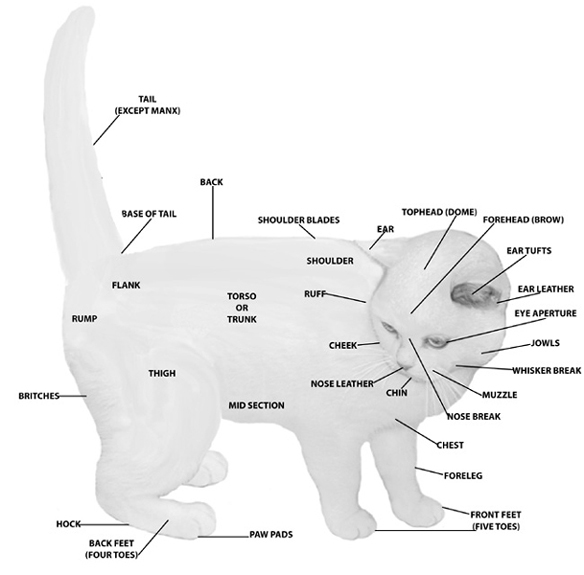
An American Shorthair has a large head with a full-cheeked face giving the impression of an oval just slightly longer than it is wide. Its eyes have an upper lid shaped like half an almond (cut lengthwise), while the lower lid is a rounded curve. The unique shape that helps protect the eyes from injury produces a sweet, wide-open expression. The American’s medium length nose curves gently from the bridge to the forehead. It has a firm chin, wide muzzle, and powerful jaw that would enable it to easily kill its prey.
The glistening coat is short, thick, and hard in texture. The coat is dense enough to protect the cat from moisture, cold, and brambles if it was running through the woods. Everything about an American Shorthair makes it look as if it could take care of itself in the wild.
Records indicate several shorthaired cats arrived in North America on the Mayflower and various other ships. Although they probably sneaked aboard, they were soon revered for controlling the rodent population on the ships and later on the settlers’ farms. Those American barn cats were selected more for ruggedness and natural hunting talent than for their beauty. However, as the American cat population grew, farmers began to keep the kittens that appealed to them based on flashy colors, bold patterns, general conformation, and disposition.
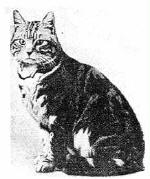
The first formal cat show in the United States was held at Madison Square Garden in 1895. The American cat, simply named,Shorthair, provided forty-six adults and twenty-five kitten entries in the show. Many were listed for sale for higher prices than the imported Siamese and Persians. The Cat Fanciers’ Association (CFA) chose to recognize this lovely breed of cat as one of its first five pedigreed breeds of cats. The first Shorthair registered in CFA was born in 1900. He was an orange (red) tabby named Ch. Belle of Bradford.
The success of the Shorthair in the show ring grew through the years. At the same time, cat shows grew in popularity, and many more breeds were created and imported. By 1930, breeders of the Shorthairs came to believe their breed needed a more distinctive name. The name Domestic Shorthair was selected to represent the strain of cat developed domestically – in America. The name change proved to be a grave mistake. A name that was intended to distinguish American-bred cats from the imported or man-made breeds came to be equated with domestic (household) servants. The name sent the breed from riches to rags. For the next thirty years, the breed struggled in popularity.
By 1961, fanciers of the breed realized another name change was needed. Through their efforts, the breed carries its current name – American Shorthair. The name is now consistent with the idea that our native North American breed of shorthaired cat is distinctly different from cats found in the neighborhoods and barnyards today. By chance, a non-pedigreed shorthaired cat might resemble an American Shorthair, just as any given domestic cat might look like a Siamese or a Persian. The test, however, is in whether that animal can consistently produce kittens of the same conformation, coat quality, and temperament in the same manner as a pedigreed cat. Years of selective breeding and the recording of many generations of cats are what enable today’s breeders to be certain that each litter of kittens will have specific qualities. Each litter is planned in order to produce the finest representatives of the breed.
The breed returned from rags to riches throughout the world. In 1965, an American Shorthair gained the coveted title of Cat of the Year. Many Americans have earned national and regional titles since that time, including additional Cat of the Year wins in 1984and 1996. For the breed to have produced three such cats is quite a record. In fact, the American Shorthair is the only shorthaired breed to earn the title since the 1970s.
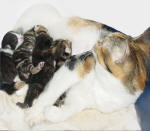
Known as a cat of many colors, the American Shorthair has more than eighty different colors and patterns. Ranging from handsome brown tabby to glistening blue-eyed white, shimmering shaded cameo to flashy calico, striking tabby and white to subtle dilute, and many colors in between, the American has made its mark in the cat fancy. The most widely recognized American Shorthair color and pattern is the silver classic tabby with dense black markings on a sparkling silver background. Consistently in the top ten most popular breeds of cat, the American Shorthair has truly come into its own.
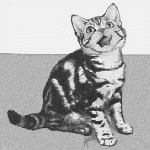
As long as it is kept indoors, an American will live, on average, fifteen to twenty years with only annual veterinary checkups. A healthy American Shorthair is a low maintenance cat. If it is not to be part of a breeding program, it is recommended that it is neutered or spayed. After that, the only requirements are keeping the claws clipped and the coat tidy. By starting the grooming procedures when the cat is young, and making it part of the daily routine, your American Shorthair will enjoy being groomed.
Cats shed. The American Shorthair is no exception. However, this can be kept to a minimum by weekly (more frequent, if desired) combing. It is recommended that a metal comb or rubber brush be used since plastic combs and brushes tend to break the coat. Another tool used by breeders is a chamois – just like you might use to wash your car. However when purchasing one for your cat, be certain it has not been treated with soap or any other chemicals. Wiping the coat with the chamois pulls out lose hair, cleans the coat, and adds luster.
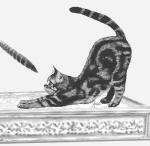
An American Shorthair does not normally require a bath unless it is going to be shown. A show bath should be given as early in the week prior to the show as possible to allow some oils to return to the coat. If you intend to show your American Shorthair, it would be a good idea to talk to the breeder of the cat prior to giving the first bath since every breeder has certain shampoos, conditioners, and treatments they prefer.
If you are bathing because the cat has gotten dirty, there are some general guidelines. Use only a shampoo recommended for cats. After shampooing, rinse thoroughly. Squeeze out as much water as possible. Towel to a damp dryness and allow the cat to finish the process. Comb through the coat when it has almost dried to smooth the coat and remove loosened hair. Always keep the cat in a warm area until it has completely dried.
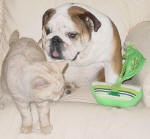
The American Shorthair is a very social cat. It enjoys people and other animals. Naptime usually finds it curled in someone’s lap or snuggled next to another cat. Even though it loves to be held, the American Shorthair typically wants to have at least its back feet on a solid surface. This could be your hand supporting the hindquarters while you carry the cat or in the case of a show ring, the judge’s table. The fact that the cat likes to have its rear legs supported is probably due to the distribution of its body weight. It may also be why a seven-pound female can manage to feel like she carries fifty pounds on one foot when she steps onto your lap to get attention.
Although the breed is very affectionate, they do not require constant attention. They are very adept at entertaining themselves. An American frequently finds imaginary ‘friends’ with whom to play. Or, maybe they are refreshing mouse hunting skills from by-gone days. Whatever it is, they can play happily for a long time with something that is not visible to the human eye. They also love to be part of a communal game, chasing a toy on a string or attacking a waving feather.
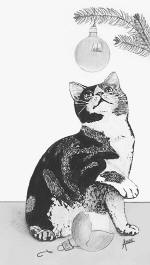
While they enjoy high places, like the top shelf of the climbing tree, they are easily trained not to jump onto a counter or bookcase. They also quickly learn to use a scratching post instead of the furniture for claw sharpening.
Generally, an American Shorthair is a sedate cat. However, once in a while, one American can make itself sound like a herd of elephants running down the hall. This usually occurs when they are in the middle of play with their invisible friendss. It is difficult to determine if the cat is chasing, being chased, or just running for the sake of running. Most of the time, the American simply exhibits a quiet patience. They will sit for many minutes waiting for a special treat. It is very easy to understand why they were successful mousers. The need for quiet during hunting may explain one of the most comical attributes of the American Shorthair. Although they are very talkative, they rarely ‘speak’. An American frequently walks up to its human, opens its mouth, but makes no sound. Yet, by its facial expression, it is easy to understand what it said since they train us very well. The breed is well known for its silent meow.
Part of the human training provides us with little glimpses of their subtle sense of humor. Humor is often used if it is time for attention, but the attention is not forthcoming. At that point, a bite on the human’s bare toe might be in order. The first time, will be hard enough to create a reaction from the human and cause the cat to roll with glee. From that day forward, it will be a little love-bite accompanied by a grin and wag of the expressive tail as a reminder of what could occur.

Based on its stamina and early ancestry, the American Shorthair is considered to be a true working breed of cat. However, most modern-day cats are on strike. They prefer to stay in the house and allow their humans do all the work. But, when necessary, they will rise to the occasion. For example, a large snake found its way into this author’s house. An eight-pound female made quick work of it. For weeks afterwards, one of her kittens carried a stick through the house growling and shaking it in imitation of its mother.
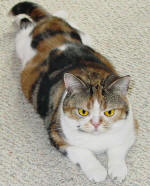
The breed is very adaptable. They travel well, and seem to thrive on visiting new, interesting places. It is best to start the cat’s travel experiences at an early age. When possible, introduce a kitten to travel in the company of an older, experienced cat. To let the kitten know it is going to return home unharmed, try to take it on several short trips in advance of its first long trip to a show or the vets. And, it is especially important not to have trips to the vet be the cat’s only travel experience.
When it is time to add an American Shorthair to your family, remember they have worked very hard to earn their well-deserved place in the world of pedigreed cats. Plan to keep your cat indoors, and let it remain on strike, so it can spend many years resting on the foot of your bed.

